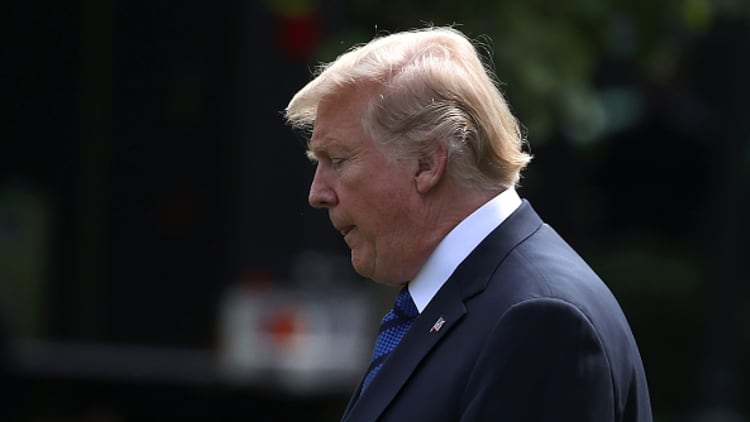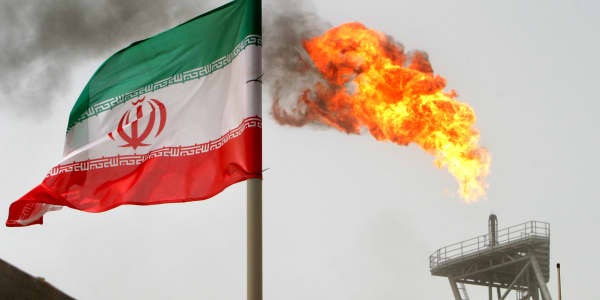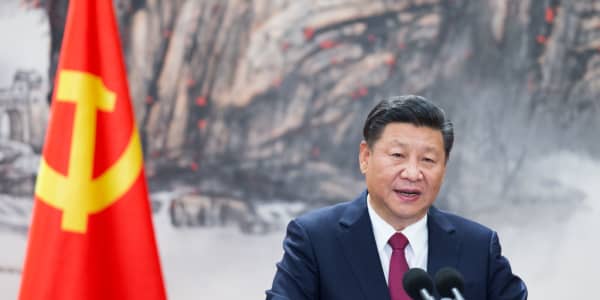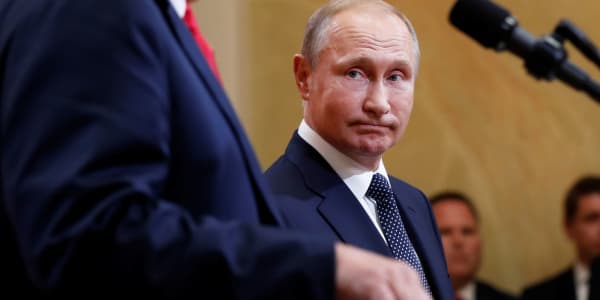President Donald Trump has been talking a lot about controlling global oil prices, tweeting about Saudi Arabia’s need to ramp up production and, during a press conference with Russian President Vladimir Putin, posing the idea of "regulating oil prices."
There is good reason for Trump to be concerned. His administration's plan to sanction Iranian oil exports in November will create a significant global oil-supply decline. Oil prices that spike too quickly have caused past economic recessions, and the U.S. economy already is running hot ahead of midterm elections taking place when the Iran sanctions start in November.
For these reasons, there has been speculation Trump may seek to tap the U.S. Strategic Petroleum Reserve. The Trump administration also is reportedly lobbying international allies to release emergency stockpiles through the International Energy Agency, though the president's administration remains divided over the idea. The IEA denied the reports, telling the press “there have been no specific discussions about an emergency stock release.”
If Trump were to tap the Strategic Petroleum Reserve — the world’s largest supply of emergency crude oil, 660 million barrels stored in massive underground salt caverns off the coast of the Gulf of Mexico — it would be the first time that an SPR release was deliberately planned in advance.
Experts say this would set a precedent. Antoine Halff, senior research scholar and the head of the program on global oil markets at Columbia University’s Center on Global Energy Policy, said the SPR was never officially or explicitly intended as a tool of price management in order to reduce oil prices. Instead, it is to be used as a buffer stock of oil in an emergency and as a deterrent against the use of oil as a political weapon.
SPR oil has been released 19 times, according to the Department of Energy, as a result of supply chain disruptions. It was created by the Ford administration after the OPEC oil embargo of 1973. There have been three "emergency" situations that has resulted in the SPR being tapped, according to energy market experts: after Operation Desert Storm in 1991, which took out Middle Eastern oil supply; after Hurricane Katrina in 2005 and after the 2011 conflict in Libya, which led to supply disruptions.
Concerns about rising oil prices are real and “self-inflicted,” Halff said, due to the government’s Iran policy. But if Trump were to use the SPR in an attempt to alleviate the impact of sanctions and reduce gas prices in the United States, it isn't likely to work.
Scott Montgomery of the Henry M. Jackson School of International Studies at the University of Washington said tapping the SPR would be “foolish and an extraordinarily bad precedent.”
He believes that using the SPR to manipulate prices, especially ahead of an election, would turn the SPR into a political weapon and likely lead to new restrictions on its use. And Trump would need to release an unprecedented amount of oil, 1 to 2 million barrels a day; Iran produces roughly 2 million barrels. That is not possible to do in a cost-efficient way, Montgomery said, because U.S. refineries are near 100 percent capacity already. The United States would have to arrange for the released oil to be refined outside the country and then sold back to the United States, which ultimately would increase prices compared to domestically produced gas.
Gas prices have been rising, and crude oil is up more than 20 percent in 2018, but historically, oil prices are nowhere near the level that would send a shock through the U.S. economy, such as in 2008 when crude oil was near $150 and gasoline prices topped $4 a gallon.
“Gas/diesel prices are not especially high at all," Montgomery said.
Between 2011 and late 2014, oil prices were again above $100, and prices for refined fuels were nearly 30 percent higher, he noted.
Oil prices were slightly higher on Wednesday, with WTI crude nearing $69 and Brent crude near $74.

According to Halff, there is no way to ever use the SPR to permanently keep oil prices low, but the president could hope to create a price rally by releasing SPR oil leading up to the November 2018 midterms. He said it’s doubtful that OPEC would comply with the president’s calls — in an April tweet Trump lashed out at OPEC for what he alleged was artificial price controls on oil at a time of record production. More recently, Trump tweeted that Saudi Arabia had agreed to increase supply. But Halff said the Saudis have not significantly changed their output, and he is equally doubtful that IEA members would agree on a joint release.
Saudi Arabia did increase its production in June by 500,000 barrels but has more recently indicated that it cannot increase exports by much more.
Kenneth B. Medlock III, senior director of the Center for Energy Studies at Rice University’s Baker Institute, said there is a stronger correlation in the historical data between commercial oil stocks and oil prices than any SPR release. He believes that the delay between the decision to tap the reserve and actual sales of barrels is undercut by markets that have already adjusted. For example, if a decision was made in late July to tap the reserve, it would not have an effect in the market until Labor Day. “There is little evidence to support the SPR having been used to successfully stimulate economic activity, particularly when one considers all of the various factors that factor into the economy,” Medlock said.
During the oil embargo of 1973, Arab members of the Organization of Petroleum Exporting Countries (OPEC) cut off oil exports to the United States in the wake of American support of Israel. Rising oil prices and long lines at the gas station made the United States realize its reliance on Middle Eastern oil and the drastic impact a shortage could have on the domestic economy. The Strategic Petroleum Reserve was created as a deterrent to future embargoes against the United States.
Montgomery said because Iran’s largest customer for oil, China, is not expected to stop buying when U.S. sanctions start in November, an SPR release is not even necessary. But experts remain divided on how much of a global supply loss will result. Medlock believes the market will tighten as a result of lost barrels from Iran, as well as other key oil-producing countries where supply problems exist, such as Venezuela. Most energy experts do not expect Iran's entire supply of roughly 2 million barrels to go offline — China buys one-quarter of Iran's oil — but they do expect a significant decrease in November.
There is little evidence to support the SPR having been used to successfully stimulate economic activity, particularly when one considers all of the various factors that factor into the economy.Kenneth B. Medlock IIIsenior director of the Center for Energy Studies at Rice University’s Baker Institute
In 1975 Congress created the Energy Policy and Conservation Act, which founded the SPR, to increase energy supplies, curtail demand and prepare for energy emergencies. The International Energy Agency's 30 members also established strategic oil reserves, worth 90 days of net imports. Each country can decide how to use their stock and does not need IEA permission to utilize its resources, including the SPR.
In 1991, President George H. W. Bush released 33.75 million barrels from the SPR in the wake of Operation Desert Storm, which disrupted oil activities in the Middle East. Montgomery said that after Iraq invaded Kuwait in 1990, prices rose from an average of $18.33 to $23.19, or about 20 percent. After the release from the SPR and increased production from Saudi Arabia, prices settled at $19.25 in 1992.
In the wake of Hurricane Katrina in 2005, all production in the Gulf of Mexico, which was about 25 percent of domestic production, was shut down. Bush released 60 million barrels in a coordinated response with the IEA and a coalition of 28 member countries. It was followed by the Hurricane Katrina Exchange, where the government loaned oil in order to assist companies that had disruptions in production due to the hurricane. Through this exchange in 2005, almost 21 million barrels of oil were either loaned or sold.
In 2011 the IEA, including the United States, released 60 million barrels of oil due to the supply disruptions that were taking place in Libya. The United States provided half of that.
Budget deficit concerns also factor in future SPR strategy
The Trump White House has proposed selling a significant portion of the SPR to reduce the federal deficit. In 2018 the administration proposed putting 270 million barrels of SPR crude oil on the market between 2022 and 2027, stating that a smaller SPR is projected to continue to meet international obligations and emergency needs.
In this regard, Trump is not breaking with presidential precedent.
The SPR was used during the Clinton administration in order to reduce the budget deficit. Reid Stevens, assistant professor of the Department of Agricultural Economics at Texas A&M University, said that the oil markets were relatively stable and prices were low in the mid-1990s, but SPR oil was still sold to reduce the deficit.
During the Obama administration the government sold SPR reserves to finance infrastructure improvements in the reserve itself, and the Obama administration also supported a policy of selling SPR crude to finance broader government budget needs. Trump's administration has proposed selling as much as half of the reserve, a policy that has defenders — given the huge increase in oil production from hydraulic fracturing — and detractors, who think the SPR is being misappropriated. The conservative think tank Heritage Group has proposed selling off the entire reserve.
Trump's loudest weapon may be the only one he has in the end when it comes to global oil prices. "There's not much Trump can do about the oil policy except for talking about it," Daniel Yergin, vice chairman of IHS Markit recently told CNBC's "Squawk Box."




